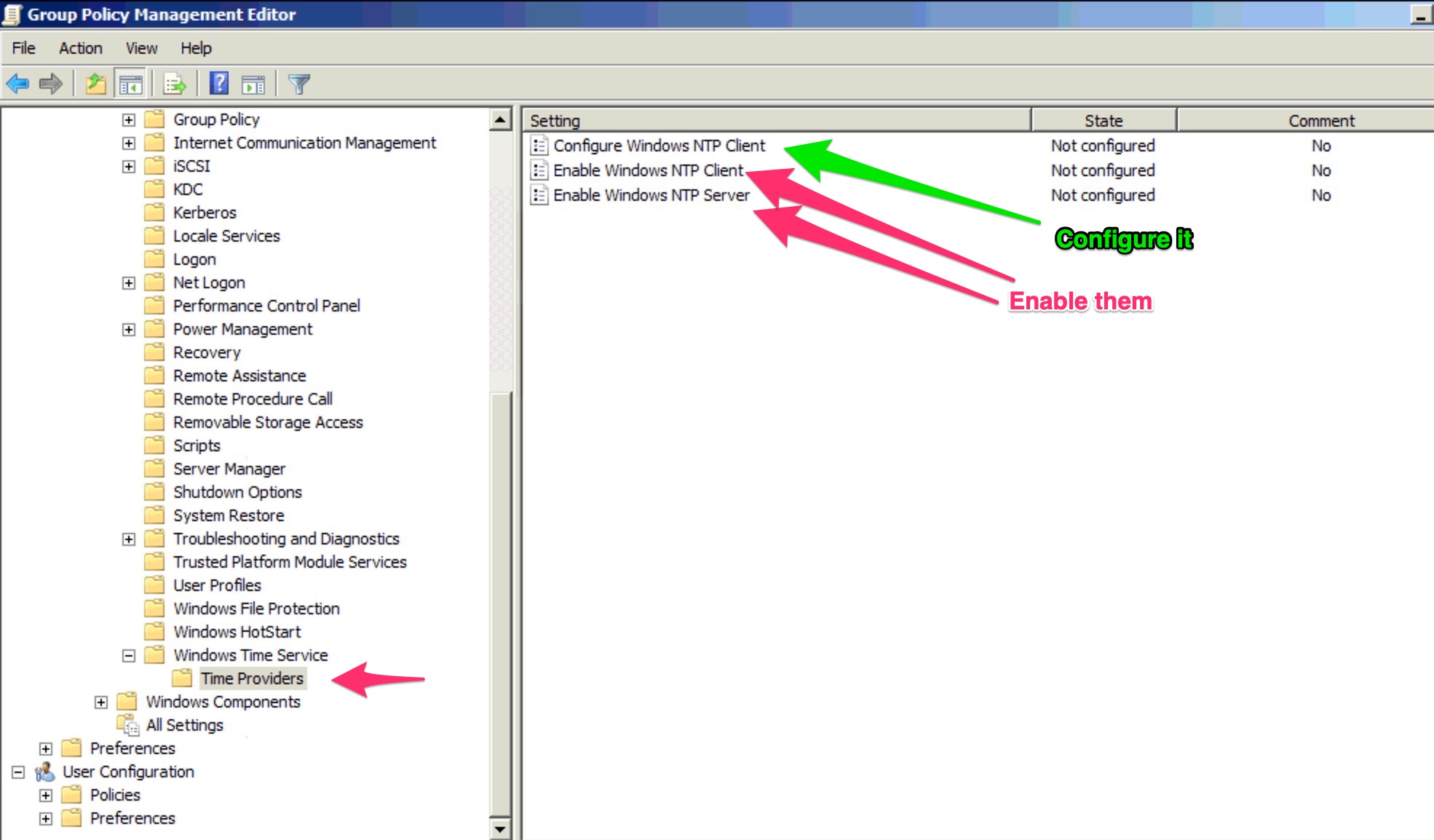Configure Windows Ntp Client Group Policy
By default the local Network Time Protocol NTP Client is enabled and synchronizes your computers clock to the Domain Controller. Enable Windows NTP Client.
Windows Server 2012 R2 Ntp Server Server World
The only caveat is you need 0x1 appended to each server name.

Configure windows ntp client group policy. By default only the first domain controller or so-called Root domain controller and. All other settings with default configuration. Enable Windows NTP Server.
Give your new policy a name that indicates what it will do such as NTP Client. Sometimes the clock on our Windows client computers goes behind or goes ahead of what the actual time. Enable the Windows NTP Client and edit configure Windows NTP Client like this.
Even though the name is singluar NtpServer not NtpServers you can put more than one server in there space separated. On the left pane enabled the following two settings. Configuring Time Service - A short explanation the default Windows Time Server settings can meet your requirements.
In our environment we have 1 windows 2k8 R2 server - Server 1 Server 1 is PDC We have over 100 XPWin 7 computers Server 1 is configured as authoritative time server ISSUE. Configure the external time sources type. Enable Windows NTP Client Configure Windows NTP Client Entered the NTP server information when in.
Templates-System-Windows Time Service-Time Providers Enable Windows NTP Client Enabled. Computer configuration - policies - administrative templates - system - windows time service - time providers. Right-click your new Group Policy Object and select the Edit option.
Enabled policy settings are described below. The GPO is Computer Configuration Policies Administrative Templates SystemWindows Time ServiceTime Providers Configure Windows NTP Client. Hi The Group Policy Configure Windows NTP Client specifies a set of parameters for controlling the Windows NTP Client.
Using gpeditmsc went to Administrative template - System - Windows Time Service - Time Providers. Computer Configuration Administrative Templates System Windows Time Service Time Providers. Right-click on Group Policy Objects and click New.
There you can configure which ntp server should be used in the first NtpServer field. Computer Configuration Policies Administrative Templates. I want to create a group policy which can force a client to sync with Server 1 for time settings.
RootCIMv2 Select from Win32_ComputerSystem where DomainRole 5 With. Group Policy NTP and regional setting. I also configured a WMI Filter for this GPO that it is only applying to the PDC Emulator.
Open Group Policy Management create and link to root tree a new GPO called Time-Sync-to-DC Edit it and go to Computer Configuration Administrative TemplatesSystemWindows Time ServiceTime Providers. GP Friendly name. Thanks for your time and help.
So domain controller will be NTP server for domain and all windows domain client take right time from DC. Stop the W32Time service. GP ADMX file name.
GPO for PDC Server setting. In the GPO Editor go to the following section Computer Configuration Administrative Templates System Windows Time Service Time Providers and enable the policy Configure Windows NTP Client. This policy setting specifies whether the Windows NTP Client is enabledEnabling the Windows NTP Client allows your computer to synchronize its computer clock with other NTP servers.
Enable the following policy settings. According to the following sections of the Microsoft KB article. This value is in the form of dnsNameflags where flags is a hexadecimal bitmask of the flags for that host.
Gpo-ntp-settingspng 404 KiB Comment. Right-click the container and choose Create and Link a GPO Here from the context menu. On the group policy editor screen expand the Computer configuration folder and locate the following item.
Open the command prompt and type. Configure Windows NTP Client. You might want to disable this service if you decide to use a third-party time providerIf you enable this policy setting you can set the local computer clock to synchronize time with.
SystemWindows Time ServiceTime Providers. The Domain Name System DNS name or IP address of an NTP time source. To do this create a new GPO and assign it to the OU with computers.
Comment Show 1. Configure Windows NTP Client. Log in to your PDC Server and open the command prompt.
Go to the following section of Group Policy Editor Console. To set the policy open the Group Policy Management tool on a domain controller or on a computer running Remote Server Administration Tools. You can also synchronize to a different NTP server by.
If you do not want your local NTP service to synchronize to the NTP service on the Domain Controller explicitly disable the Windows Enable Windows NTP Client group policy. Type a name for the policy such as Client Time Synchronization and then choose OK Right-click the policy you created and choose Edit from the context menu. Enable Windows NTP Client.
This is the GPO that is currently the NTP GPO.
Configure Ntp Time Sync Using Group Policy Theitbros
Windows Pdc Use Gpo To Point Microsemi Device Ip Addresses Microsoft Q A
Setting A Right Time Synchronisation In A Microsoft Windows Domain Marco Schiavon
Windows Setting Domain Time Petenetlive
Group Policy Ntp And Regional Setting Microsoft Q A
Multiple Timeserver Sources In Gpo
Configure Ntp Time Sync Using Group Policy Theitbros
Setting A Right Time Synchronisation In A Microsoft Windows Domain Marco Schiavon
Configure Ntp Time Sync Using Group Policy Theitbros
Windows Server 2012 R2 Ntp Client Server World
Setting A Right Time Synchronisation In A Microsoft Windows Domain Marco Schiavon
Configure Ntp Time Sync Using Group Policy Theitbros
Tutorial Gpo Ntp Client Configuration Step By Step
Setting Up And Managing Ntp Active Directory Gpo
Solved Ntp Windows Clients Sync To Centos Server Networking
Time Server Settings In A Windows Domain
Configure Ntp Time Sync Using Group Policy Theitbros
Configuring Ntp On Windows Using Gpo Sysadmin Lab
Configuring Ntp On Windows Using Gpo Sysadmin Lab









Post a Comment for "Configure Windows Ntp Client Group Policy"